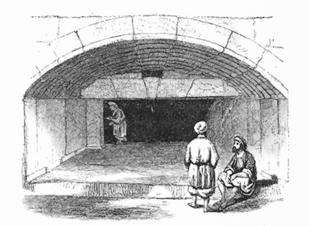James Turner Barclay

James Turner Barclay (born May 22, 1807 in King William County , Virginia , † October 20, 1874 in Bethany , Brooke County , West Virginia ) was an American missionary and explorer of Palestine.
Life
James Turner Barclay was one of four children of Robert Barclay and Sarah Coleman Turner. In 1809 Robert Barclay drowned in the Rappahannock River , and the widow married John Harris, a wealthy cotton merchant and owner of large estates in Albemarle County .
He enabled his stepson James Turner Barclay to study medicine at the University of Pennsylvania , which he completed in 1828 with a PhD. In 1830 he married Julia Ann Sowers. The couple settled in Charlottesville , where James Turner Barclay ran a pharmacy and devoted himself to drug development.
In 1831 he bought Monticello , Thomas Jefferson's country estate , and carried out much criticized changes there in order to start a sericulture . As early as 1836, for financial reasons, he was forced to sell the estate to Uriah Levy.
Barclay had turned to Presbyterianism since his marriage . He became increasingly religious, joined the Disciples of Christ Church, which emerged from Presbyterianism, and became a preacher of this church in Scottsville. The rapidly growing Disciples of Christ Church sent Barclay to Jerusalem as their first foreign missionary from 1851 to 1854.
Barclay saw the immigration of Jews to Palestine as a sign of the end times and wanted to participate in salvation history by winning these religious Jews in Jerusalem for Jesus Christ ( millenarianism ). To his disappointment, he met with rejection and could only baptize a few people. He worked mainly as a doctor and mainly treated malaria cases . He began with geographical and archaeological studies, he also supported Edward Robinson in his research.
One of his patients was a Turkish architect who was doing repair work on the Dome of the Rock . This gave Barclay the opportunity to roam around the Haram escharif as his assistant, making drawings and measurements. Financial reasons led to the abandonment of the first Palestine mission.
Back in the United States, Barclay found a job with the Philadelphia Mint for his metallurgical skills.
In 1857 Barclay published the extensive work The City of the Great King . The illustrations are based on Barclay's photographs and drawings. In the same year, Barclay and his family returned to Jerusalem for another eight years. From 1868 he taught science at Bethany College in West Virginia, an institution of the Disciples of Christ Church. He spent his old age as a preacher in Alabama.
Barclay's grave is in Campbell Cemetery in Bethany, Brooke County, West Virginia.
Research in Jerusalem
Barclay is known as the explorer of the Barclay Gate, an ancient gateway to the Jerusalem Temple, named after him . In 1848, coming from the Haram, he discovered the lintel of the great Herodian temple gate. This is located north of the ramp to the Maghrebian Gate . “It is directly below what is now Mugaribeh Gate, and most of it is currently hidden by the house of the town clerk Abu Seul Effendi . Twenty feet and two inches of the lintel are visible today, and six feet and nine inches is its width; that's probably only half the original width. This lintel is only about four feet above the current floor level ... "
During the time he had access to the haram, Barclay continues, he discovered part of a closed gate system in the Buraq mosque in the direct vicinity of this ancient lintel; but the guards of the holy place had been so restless about his presence there that it seemed advisable to him only to make a hasty sketch and never to return. Indeed, in ancient times one could ascend through a gallery with stairs from the Barclay Gate to the level of the Herodian temple platform. In the early 14th century, this gallery was walled up in the west and converted into the small Buraq mosque.
In the winter of 1854, Barclay examined the Zedekia Cave in the north of the old city of Jerusalem and described it in more detail for the first time.
Web links
- James Turner Barclay: Adventurer, Author, Missionary, or Madman, Eretz Magazine . (Center for Online Judaic Studies)
- Dr. James Turner Barclay, Minister and Missionary . (Scottsville Museum)
- Evelyn Edson: James Turner Barclay: Resident of Scottsville, Citizen of the World . (Scottsville Museum Newsletter)
publication
- The City of the Great King, or Jerusalem as It Was, and It Is, and as It Is To Be . Philadelphia 1857 (Reprint New York 1977) archive.org
literature
- Paul M. Blowers: James Turner Barclay. In: Douglas A. Foster, Anthony L. Dunnavant, Paul M. Blowers (Eds.): The Encyclopedia of the Stone-Campbell Movement . Eerdmans, 2004, ISBN 0-8028-3898-7 , pp. 69-70.
- Max Küchler : Jerusalem. A handbook and study guide to the Holy City . Vandenhoeck & Ruprecht, Göttingen 2007, ISBN 3-525-50170-6 .
Individual evidence
- ↑ James Turner Barclay. In: Find a Grave. Retrieved August 30, 2018 .
- ↑ Max Küchler: Jerusalem . S. 172-173 .
- ↑ James Turner Barclay: The City of the Great King . S. 489 .
- ↑ James Turner Barclay: The City of the Great King . S. 489-490 .
- ↑ Max Küchler: Jerusalem . S. 266 .
- ↑ Max Küchler: Jerusalem . S. 948 .
| personal data | |
|---|---|
| SURNAME | Barclay, James Turner |
| BRIEF DESCRIPTION | American missionary and Palestine explorer |
| DATE OF BIRTH | May 22, 1807 |
| PLACE OF BIRTH | King William County , Virginia |
| DATE OF DEATH | October 20, 1874 |
| Place of death | Bethany , Brooke County , West Virginia |
